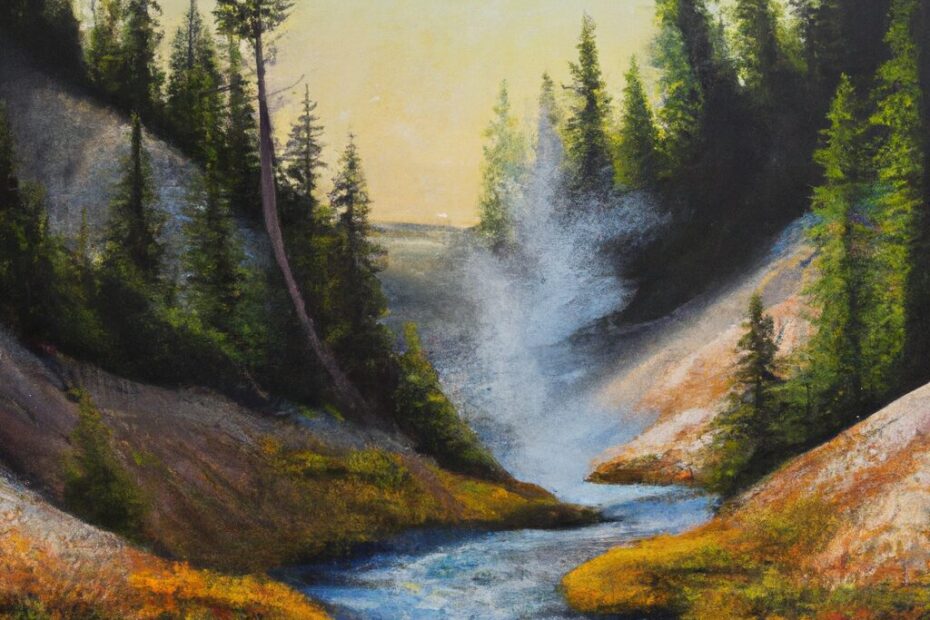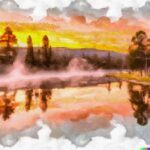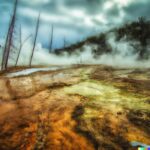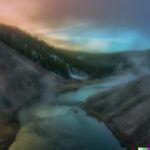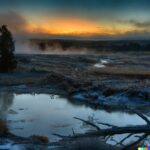Yellowstone National Park is home to some of the most mesmerizing natural wonders in the world – geysers. In this article, we will explore the fascinating world of geysers, from how they are formed to the different types found in Yellowstone.
We will also take a closer look at some notable geysers in the park, including the famous Old Faithful and Steamboat Geyser. We will discuss the importance of preserving these incredible geothermal features for future generations. Join us as we delve into the beauty and power of Yellowstone geysers.
What Are Geysers?
Geysers are natural wonders that can be found in various parts of the world, including Yellowstone National Park.
They are formed through a combination of underground water reservoirs, heat, and pressure. This results in periodic eruptions of hot water and steam. Yellowstone, known for its geysers like Old Faithful, is a prime example of such a location.
Aside from offering breathtaking displays, geysers also play a crucial role in understanding the Earth’s geothermal activity. They also provide unique habitats for specific microbial life. The presence of geysers often indicates the existence of volcanic activity, making them significant attractions for tourists and researchers alike.
How Are Geysers Formed?
The formation of geysers involves a complex interplay of geological formations, hydrothermal features, and the release of thermal energy from the Earth’s interior.
Hydrothermal features are defined by the existence of subterranean water reservoirs that are heated by magma beneath the Earth’s crust. As the water is heated, it moves upwards through cracks and permeable rock, generating pressure and resulting in the periodic eruptions that are unique to geysers.
The geological structures, including narrow constrictions in the plumbing system, also play a vital role in the accumulation of pressure and eventual explosive release of steam and water. This process of releasing geothermal energy is what sets geysers apart from other thermal features found in the Earth’s terrain.
Where Are Geysers Found?
Geysers are typically found in regions with significant geothermal phenomena, such as geyser basins, where the Earth’s geothermal wonders are on mesmerizing display.
These basins, scattered across the globe, offer visitors a glimpse into the Earth’s inner workings.
Yellowstone National Park in the United States is home to famous geyser basins like the Upper Geyser Basin and Norris Geyser Basin, where the iconic Old Faithful and Steamboat geysers captivate onlookers regularly. Similarly, Iceland’s geothermal areas, such as the Geysir Geothermal Field, showcase the remarkable power and beauty of geysers. These locations provide valuable insight into the planet’s geothermal activity and contribute to our understanding of these natural phenomena.
The Geothermal Activity of Yellowstone National Park
Yellowstone National Park is renowned for its exceptional geothermal activity, attracting visitors from around the world to witness iconic landmarks such as Old Faithful and the mesmerizing steam vents.
The park’s geothermal wonders are a testament to the Earth’s natural power, with geysers and hot springs dotting the landscape, creating a surreal and otherworldly atmosphere. “It’s like stepping into another world,” says park ranger, John Smith.
Old Faithful, one of the park’s most famous geysers, captivates onlookers with its regular, impressive eruptions. The steam vents, like Dragon’s Mouth and Black Dragon’s Cauldron, release billowing clouds of steam, adding to the park’s mystique. These geothermal features not only provide stunning visual displays but also underscore the park’s significance as a living laboratory for geologists and a haven for curious travelers.
What is the Yellowstone Caldera?
The Yellowstone Caldera is a colossal volcanic feature, showcasing the immense geological wonders shaped by past volcanic activity within Yellowstone National Park.
The Yellowstone Caldera is one of the largest supervolcanoes in the world, located above a volcanic hot spot in the western United States. This massive caldera was formed by massive eruptions millions of years ago, leaving behind a crater measuring over 30 miles wide.
Aside from its size, the Yellowstone Caldera is also known for its unique hydrothermal features, such as geysers and hot springs. These are a result of the intense heat and pressure beneath the Earth’s surface. The region’s landscapes and biodiversity have been greatly influenced by past volcanic activity, making the caldera of great geological significance.
What Makes Yellowstone Geysers Unique?
The geysers of Yellowstone are celebrated for their unique geological features, characterized by captivating displays of hydrothermal vents and other extraordinary natural phenomena.
Their mesmerizing hydrothermal vents create a spectacular sight, emitting vibrant hues and rhythmic bursts of steam, stirring the imagination with their otherworldly charm.
These geothermal wonders are a testament to the earth’s power and resilience, offering a glimpse into the planet’s inner workings. The intricate network of underground chambers and conduits serves as a reminder of the volatile forces at play beneath the seemingly placid surface of Yellowstone National Park.
Types of Geysers in Yellowstone
The geysers in Yellowstone offer a diverse array of types, with stunning displays ranging from boiling pools to expansive geyser basins.
Each type of geyser in Yellowstone has its unique characteristics. Some geysers, such as Old Faithful, are renowned for their predictable eruptions, shooting water high into the air. Others, like the Morning Glory Pool, captivate visitors with their vibrant colors and intricate formations. The geothermal features in the park showcase the dynamic and ever-changing nature of the Earth’s geology. Visitors are drawn to witness these natural wonders and to marvel at the power and beauty of Yellowstone’s geysers.
Fountain Geysers
Fountain geysers in Yellowstone are characterized by their mesmerizing thermal activity, showcasing captivating displays of hydrothermal features unique to this type of geyser.
Fountain geysers are known for their frequent and unpredictable eruptions, which can shoot steam and boiling water to impressive heights. The unique funnel-shaped and cone-like formations surrounding the geyser pools only add to their allure.
One of the most captivating aspects of these thermal marvels is the vibrant colors created by thermophiles, heat-loving microorganisms that thrive in the extreme conditions of the geysers. These colorful organisms contribute to the otherworldly beauty of the surroundings, making fountain geysers an essential part of the unparalleled hydrothermal landscape of Yellowstone National Park.
Cone Geysers
Cone geysers in Yellowstone present spectacular sights, indicative of the volcanic activity that contributes to their unique formations and mesmerizing displays.
The distinctive geysers in this area are known for their towering cones, adorned with colorful mineral deposits, and their powerful jets of scalding water and steam. These minerals create vibrant hues and intricate patterns, adding to the geysers’ visual allure and captivating visitors with their otherworldly beauty.
These geysers also serve as reminders of the underlying volcanic forces that shape the landscape and produce these stunning natural wonders for all to admire.
Fountain-Cone Geysers
The fountain-cone geysers of Yellowstone embody iconic landscapes, powered by the thermal energy that fuels their extraordinary displays of geothermal activity.
These geysers, with their majestic eruptions, are a testimony to the immense power of nature’s forces. They erupt in a spectacular fashion, projecting boiling water and steam high into the air, creating awe-inspiring scenes that have captivated visitors for generations.
The intertwining of thermal energy and natural geological formations gives rise to these breathtaking displays, shaping the unique and captivating features of Yellowstone’s geothermal landscapes.
Erupting Geysers
Erupting geysers in Yellowstone stand as environmental marvels within the expansive geyser basins, showcasing the power and beauty of their awe-inspiring displays.
Geysers, formed by the underground heating of water, are essential to the ecological balance of the region. These eruptions release pressure and heat, creating habitats for specific microbial organisms. The delicate ecosystem around the geysers depends on this hydrothermal activity, showcasing the interconnection between geology and biology.
The mineral-rich waters that flow from the geysers also play a crucial role in sustaining the vibrant and diverse flora in the area. This further demonstrates the interdependence of geothermal phenomena and the environment.
Notable Geysers in Yellowstone
Yellowstone National Park is home to several notable geysers, with Old Faithful standing as a celebrated tourist attraction, renowned for its stunning displays of natural beauty.
Visitors from around the world flock to witness the incredible eruptions of Old Faithful, where boiling water shoots up to 185 feet in the air, creating a breathtaking spectacle.
The geyser’s predictability, erupting approximately every 90 minutes, adds to its allure, allowing visitors to plan their visit and experience this natural wonder firsthand.
The park’s diverse geothermal features, including steam vents and bubbling mud pots, contribute to Yellowstone’s status as an otherworldly destination.
Old Faithful
Old Faithful in Yellowstone represents one of the park’s iconic landmarks, captivating visitors with its remarkable thermal activity and mesmerizing displays.
Old Faithful is a symbol of the park’s natural wonders, drawing in visitors from around the globe to witness its awe-inspiring eruptions.
The geyser’s reliability in its eruptions, occurring every 60-110 minutes, adds to its allure and creates a sense of anticipation and excitement for visitors.
The towering columns of boiling water and steam, often accompanied by vibrant rainbows in the sunlight, create an unforgettable spectacle that showcases the power and beauty of nature.
As one of the most famous geysers in the world, Old Faithful continues to fascinate and inspire generations of park visitors.
Steamboat Geyser
Steamboat Geyser offers extraordinary sights within Yellowstone, featuring captivating displays of hydrothermal vents and other natural phenomena that showcase its unique allure.
The geyser’s towering eruptions can reach up to 300 feet, making it the world’s tallest active geyser. Its intermittent and unpredictable eruptions add to its mystique, drawing visitors to witness the raw power of nature.
The unique geological features surrounding Steamboat Geyser, such as colorful mineral deposits and intricate terraces, provide a mesmerizing backdrop to its hydrothermal activity, creating an experience that is both educational and awe-inspiring.
Grand Geyser
Grand Geyser presents impressive natural features in Yellowstone, captivating visitors with its mesmerizing spectacle and remarkable displays of geothermal activity.
Experience the awe-inspiring power of nature at Grand Geyser, with its towering eruption reaching heights of up to 200 feet and intricate, colorful terrace formations. Witness the rhythmic bursts of scalding water and steam, reminding us of the immense forces shaping our planet. Don’t miss this essential stop for a deeper connection with nature and understanding of Earth’s dynamic geology.
How to See Geysers Safely
Observing geysers safely requires adherence to visitor guidelines that prioritize the conservation of these environmental marvels while ensuring the safety of visitors.
When visiting geysers, it is crucial to follow designated viewing areas to prevent damage to delicate ecosystems. This includes refraining from throwing objects into the geysers, as it can disrupt their natural processes and harm the environment.
Additionally, it is important to stay on marked trails and pathways to avoid accidental injury and protect the unique flora and fauna. By respecting these guidelines, visitors can contribute to the conservation efforts and safety measures in place to preserve the natural beauty of geysers.
Preserving Yellowstone’s Geysers
Preserving Yellowstone’s geysers necessitates dedicated conservation efforts aimed at safeguarding these natural wonders and ensuring their continued environmental protection.
Efforts to preserve Yellowstone’s geysers include strict regulations for visitor activities and regular inspections to minimize human impact on the delicate ecosystem. Sustainable maintenance practices are also implemented to protect the natural geothermal features. Educational programs aim to raise awareness and inspire visitors to become stewards of the environment. By fostering a culture of responsibility and respect, Yellowstone’s geysers can be protected for future generations.
Frequently Asked Questions
What are Yellowstone geysers?
Yellowstone geysers are unique geological features found in Yellowstone National Park that shoot hot water and steam into the air periodically.
How were Yellowstone geysers formed?
Yellowstone geysers are formed when hot water from underground geothermal activity rises to the surface, creating pressure and causing the water to erupt.
What makes Yellowstone geysers natural wonders?
Yellowstone geysers are natural wonders because they are rare and incredibly dynamic geological features that are only found in a few places in the world.
Are all Yellowstone geysers the same?
No, each Yellowstone geyser is unique in terms of its size, shape, and eruption patterns. Some are small and frequent, while others are large and infrequent.
Can you predict when a Yellowstone geyser will erupt?
While some geysers have relatively predictable eruption patterns, most Yellowstone geysers are unpredictable and can erupt at any time, making them even more fascinating.
Are there any safety precautions to take when visiting Yellowstone geysers?
It is important to follow all park rules and safety guidelines when visiting Yellowstone National Park to ensure your own safety and the preservation of these natural wonders. This includes staying on designated paths and never attempting to touch or interfere with the geysers.
Last Updated on January 25, 2024 by Jon Waraas – Originally Posted: January 25, 2024

I’m Jon Waraas, and I’ve been navigating the online world since 2006. By day, I’m the proud owner of some eCommerce gems, and by night, I’m the voice behind the adventures on Waraas.Com.
My heart, however, belongs to the wild beauty of Yellowstone National Park. I’ve got a collection of websites dedicated to sharing the wonders of this natural masterpiece. Oh, and did I mention? I’m currently building my own cabin inside the ghost town of Gilmore, Idaho – a cabin with tales to tell!
When I’m not immersed in the digital realm, you’ll find me lacing up my boots for a good hike or setting up camp under the star-studded sky.
